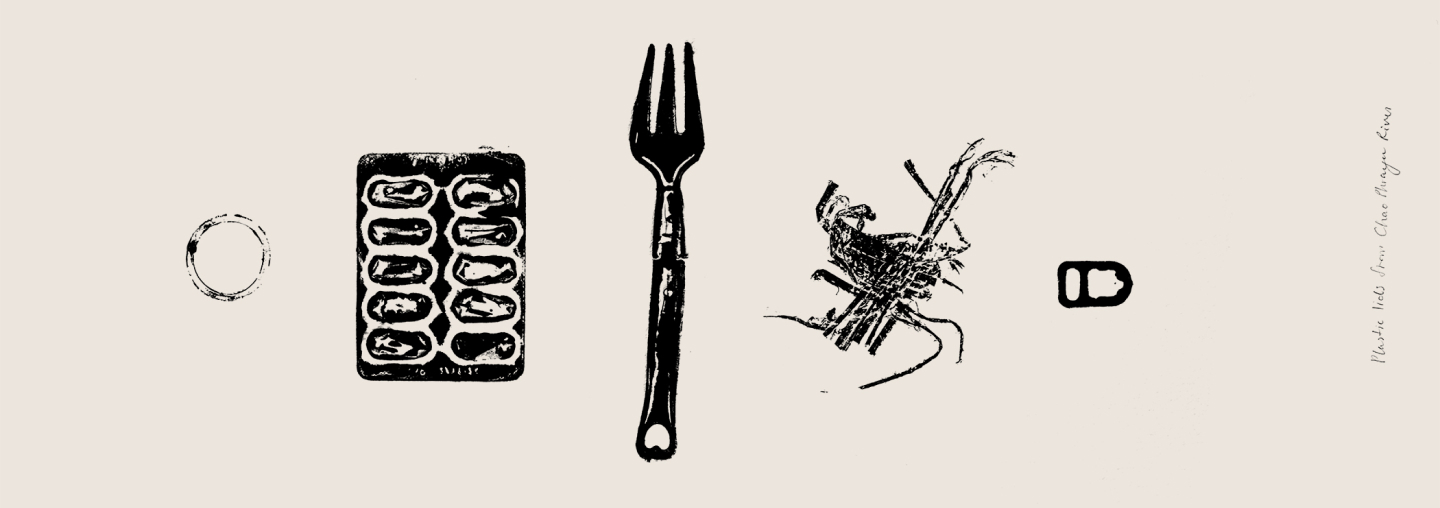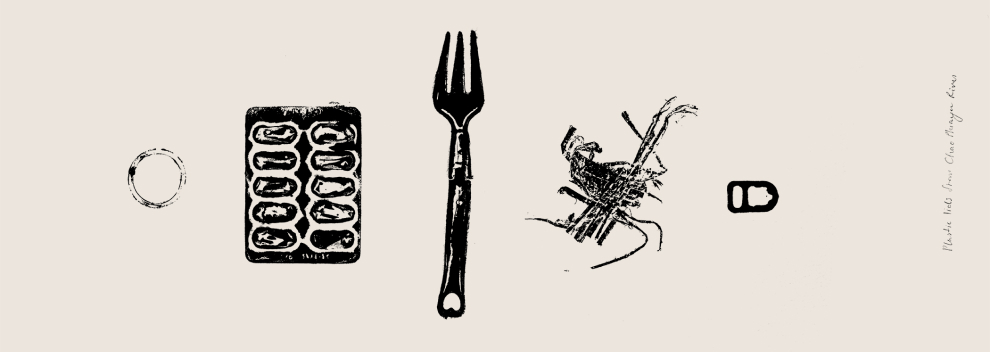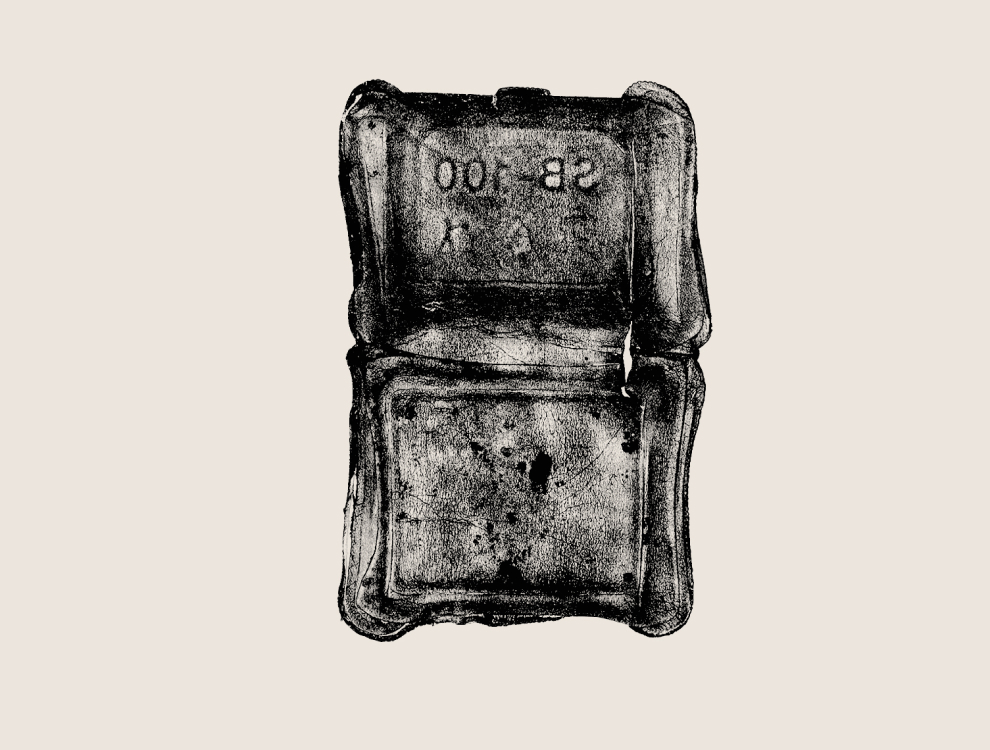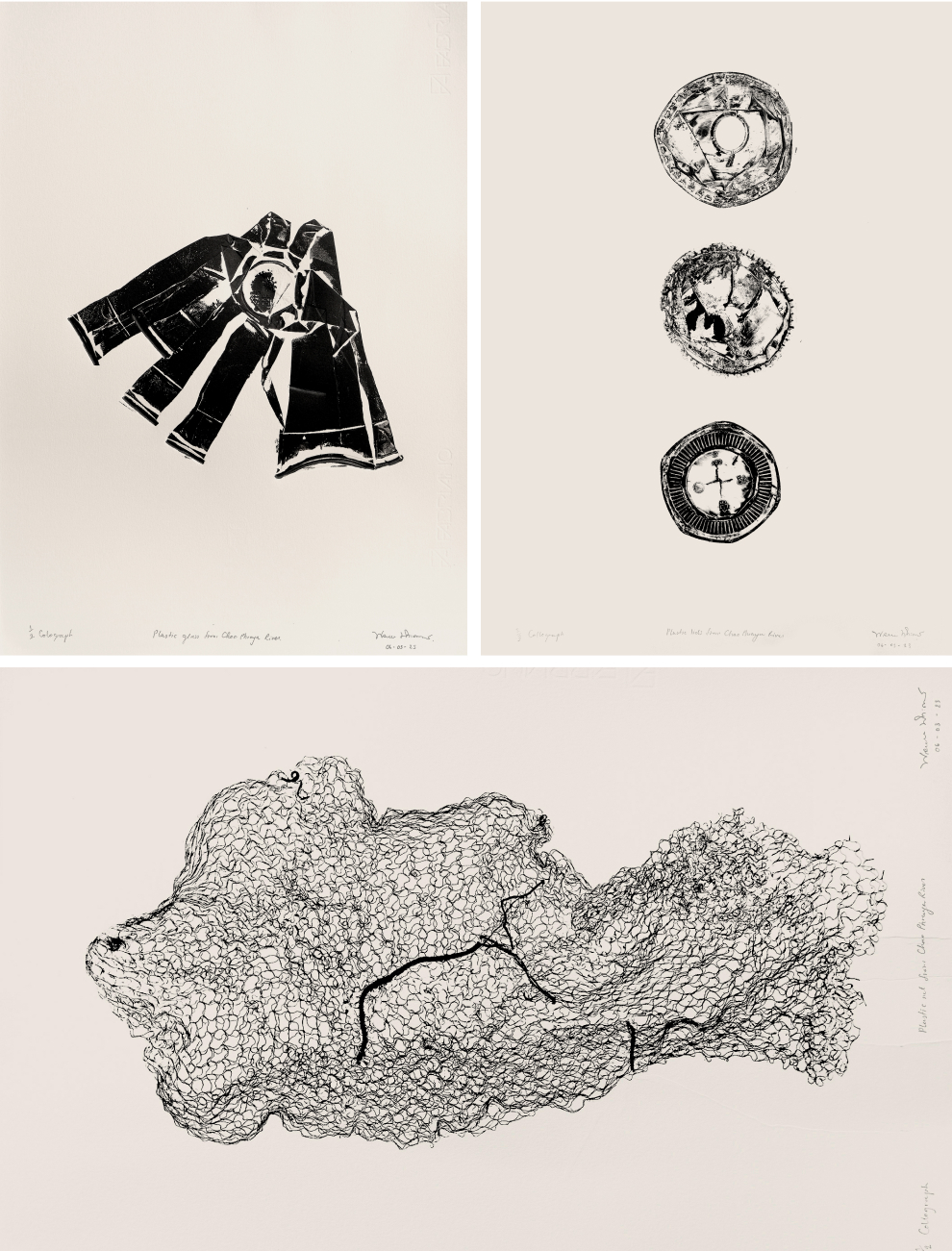
Souvenirs from Chao Phraya River
Ms. Ploy Nikadanont
Introduction :
Traditional printmaking has been applied into many areas of arts and design. It has become one of the classes that art and design students around the world have to experience. Nowadays many printmaking artists, instructors and students have to work under toxic environment since studios and classes requires the use of chemicals, many materials used in the studio are toxic and unable to be recycled. For many decades, environmental concerns have been one of the most significant issues in printmaking area. Is there a way to make it more environmentally friendly and sustainable so that the lecturers, students, and artists who work in this field can have better lives quality?
The previous experimental projects “Monsters of the Sea” (2022) found that using recycled materials such as using Tetra Pak (beverage containers that consist of aluminum foils) instead of a copper plate for the intaglio process could be a good solution since it helps cut down chemical processes and also can help reusing beverage containers. The experiments’ outcomes, however, were unsatisfactory because only Tetra Pak can be used as a matrix, while other recycled materials like plastic bottles or foam boxes cannot. It is because the characteristics of materials are not suitable for use as a matrix, resulting low quality of work.
However, to make traditional printmaking class more sustainable, it is important to use recycle material especially food packaging and beverage containers. According to research published in “Environmental International” by scientists from the Vrije Universiteit Amsterdam (2021), the majority of micro-plastic particles found in human blood are PET and polystyrene, which are commonly used in beverage containers and food packaging. And for the last 3 years with the pandemic of Covid19, the numbers of plastic waste, particularly single-use plastics, from the food delivery industry has rapidly increased. Many of these items end up in rivers and then make their way to the sea where they contribute to marine pollution, resulting marine life tainted with plastic, and we intake them. Therefore, the aim of this project is to continue searching for the approach of how to utilize recycled material, especially plastics from food and beverage containers as a material in traditional printmaking studio in order to make printmaking more sustainable by reduce chemical process and be able to create efficiently recycle system for food packaging and beverage containers before it is too late.
Objectives:
1. To find the approach to utilize recycle materials: plastic from food and beverage containers.
2. Raise the quality of work to meet the professional standards.


Methodology:
The Souvenir project’s process was developed using the framework: Double Diamond by the design councils which consists of four sections including discover, define, develop and deliver.
Discover: To understand and gain insight information on the selected topic, this section involves conducting research which is mostly a study of best practice on sustainable, non-toxic printmaking and study of artists who employ recycled materials to create works like Tony Cragg (1949) and Kurt Schwitters (1887-1948). This section also includes observation, data collection, and material collection. Due to the fact that food and beverage container particles are presented in human blood, this section also includes exploring and collecting food and beverage packaging in the river before they make their way to the sea.
Define: All data and materials collected in the previous section have been analyzed and experimented in order to define suitable materials and techniques for the project. Visual research is also included in this section since it is a method for defining a design brief that involves the development of clear design concepts and the exploration of various design directions for the subject matter. According to the experiment, when different food packaging types are used as a matrix, in this case the collagraph method, which includes an intaglio process and a relief process could create images that reflect to the design concept better than others.
Develop: The process of developing the design brief into final products began with a study of characteristic of materials collected from the river; food packaging, beverage containers and other found objects from the river since they will be printed as-is without any embellishment or manipulation. Test print including: study effect and textures of different objects on different types of printing paper such as normal watercolor paper and Fabriano paper. Also, using different weight pressures of the printing press, different types of ink and temperature.
Deliver: Following the creation of test prints to evaluate the effects and textures of each object, the composition is created by grouping the objects together. Collagraph printing was employed, while inking techniques were different depend on the particular features of each objects. The best editions were selected for the review.
Techniques and Materials:
Printmaking
“Souvenirs from Chao Phraya River” is a collection of collagraph prints created from rubbishes collected from Chao Phraya river. Not only food packaging and drink containers, but also others plastic items used in daily life such as sandals, bags, and nets. All objects used in this project have been collected in Chao Phraya river near Pom Petch in Phra Nakorn Si Ayuthaya province, where Pasak river, Lopburi river and Chao Phraya river merging, it is the point that rubbishes from many provinces are flowing together. These objects were collected and print as-is without any embellishment or manipulation to reflect what has been dumped in the river, how awful they are and how badly the ecosystem will be affected by them.
Collagraph techniques were chosen to depict the concept because they provide a negative and toxic vibe which fit well with the pollution-related subject that bringing attention to environmental issues before it is too late.
showed in pictures. Every objects were pulled from the river by using tongs. Then they were cleaned in the dishwasher and dried outside. Wetting Fabriano papers and putting a registration mark in the printing press are the first steps in the printing process. Each object was then inked, some using a roller since they have flat texture and others with a hand to push ink into a groove to display details of textures when printed. Finished works will be place under wood board and leave to dry.

Conclusion:
According to the project’s objectives, which included recycling food and beverage packaging, make the class become more sustainable by reduce waste from the printmaking process and improve quality of
work to meet the professional standards, the results were analyzed using SWOT analysis below:
Objective – 1.To find the approach to utilize recycle materials: plastic from food and beverage containers.
Strength – Non-acid process, Can applied SDG policy to printmaking class (ICCD222 Traditional Techniques Studio)
Weakness – Cannot develop 100% recycling system
Opportunity – Develop inking and printing methods to be appropriate for each type of materials. Explore new materials and tools. And increase opportunity to Invent new printing method. Can be a study case for develop ICCD222 Traditional Techniques Studio to be more sustainable by using recycle materials.
Threats – Leftover food and beverage packaging are non-recyclable. Using N15 Technology to terminate leftover materials resulting carbon footprint. Found objects from the river are very dirty, need to be very careful when collecting and cleaning. Some items are very difficult to use; relief was too high to push in the the printing press/ not absorb ink.
Objective – 2. Raise the quality of work to meet the professional standards.
Strength – Unique look and feel
Weakness – Lack of variety in aesthetic expression: Can provide only negative vibes/ Can fit in only one type of aesthetic which is “ugliness”
Opportunity – Increase opportunity to create new ways for aesthetic expression.
Threats – Mix method are not an ideal for traditional printmaking area. Textures and effects occur unexpectedly.
In conclusion, for the objective number one, which aim to find the approach to utilize recycle materials especially plastic from food and beverage containers. The advantage of utilizing the Collagraph method for print recycle materials is that no acids or chemicals were utilized. However, the items that collected from the river were extremely unclean which could affect health in different way. And some of them were very challenging for inking and printing. Also, leftover materials cannot be recycled; the only way to dispose of them is with N15 technology, which will result in an increase in carbon footprint. Using recycled materials can be a case study on how to make traditional printing classes more sustainable and increase a chance to implement SDG policy in the classroom.
For the objective number two that aiming to raise the quality of work to meet the professional standards. Using recycled materials as a matrix in a collagraph technique may express negative feeling better than positive which making the work lack variety in terms of aesthetic expression. However, negative and unpleasant appearance are considered as another form of aesthetic according to Max Dessoir’s theory. Therefore, the unpleasant appearance may pleasing to the eyes. In terms of craftsmanship, the artist can only improvise or go with the flow because all effects and marks occur unexpectedly, resulting challenge to control quality of work. However, it provides a unique look and feel which could increase an opportunity to meet the standards of contemporary printmaking but with mixed techniques of printing this would not be an ideal for traditional printmaking area.
References:
1. Northcote, J. (2022) Print Plates make of packaging. Jane Sketching: https://janesketching.com/packaging-prints/
2. Derdy Print Open (2022), Karen Wick. Artist Statement: https://www.derbyprintopen.org/printmakers/karen-wicks
3. Printing Center of New Jersey. Non-toxic and sustainable printing practices: https://www.printnj.org/non-toxic-printmaking.html
4. Connellan L. (2021). Print from a recycle carton. Instructables craft: https://www.instructables.com/Print-From-a-Recycled-Carton/
5. Dessoir M. (1926) Aesthetic and Philosophy of art in contemporary Germany. Oxford University Press. 36-2, P.229-310: URL: https://www.jstor.org/stable/27901066
6. Sonal, P. Newsprint primer: Newsprint Manufacturing, Grades, Properties, Storage, Transportation, and Recycling. Paper Index Academy. https://www.paperindex.com/academy/paper.grades/newsprint-primer
7. Fabriano Company (2021). Born with paper, from Asia Europe and Across the world. https://fabriano.com/en/history/
8. Nicole,W. (2021). Microplastics in Seafood: How Much Are People Eating? Environmental Health Perspective,129(3). https://doi.org/10.1289/EHP8936
9. Frias, J.P.G.L. & Nash, R. (2018). Microplastics: Finding a consensus on the definition.Marine Pollution Bulletin, 138, 145-147. https://doi.org/10.1016/j.marpolbul.2018.11.022
10. Gibbens, S. (2019). You eat thousands of bits of plastic every year, NationalGeographic, https://www.nationalgeographic.com/environment/article/you-eat.thousands-of-bits-of-plastic-every-year
11.Carrington, D. (2022) Microplastics found in human blood for first time, The Guardian,
https://www.theguardian.com/environment/2022/mar/24/microplastics.found-in-human-blood-for-first-time
12. Design Council, What is the framework for innovation? Design Council’s evolved Double Diamond,https://www.designcouncil.org.uk/news-opinion/what.framework-innovationdesigncouncils-evolved-double-diamond
13. The Royal Society of Painter-Printmakers. (2023). Printmaking Explain, https://www.re-printmakers.com/printmaking-explained/intaglio/
14. Cragg T. (2016). Tony Cragg Restrospective: Part of the world at Von Der Heydt-Museum, Wuppertal 9.04.2016-14.08.2016. https://www.tony-cragg.com/works/current/tony-cragg-restrospective.parts-of-the-world-at-von-der-heydt-museum-wuppertal-19-04-2016-14.08-2016.html
15. Guggenheim Museum, Kurt Schwitters, https://www.guggenheim.org/artwork/artist/kurt-schwitters
16. Museum of Modern Arts, Kurt Schwitters, https://www.moma.org/artists/5293